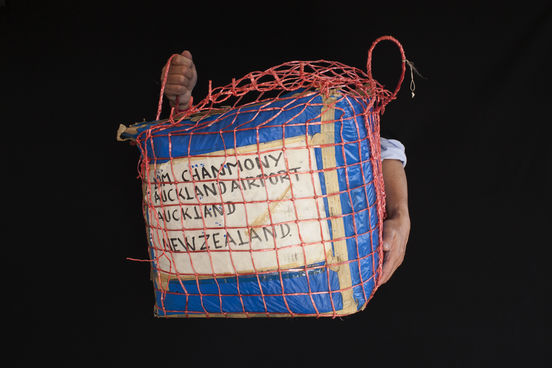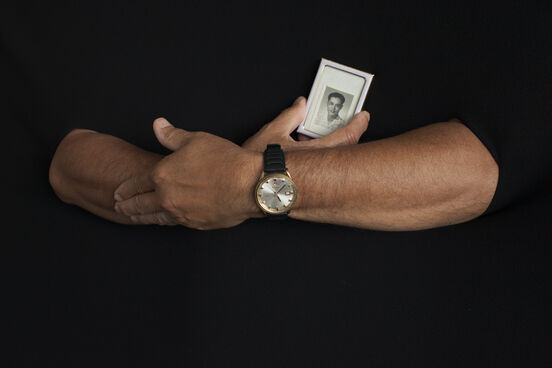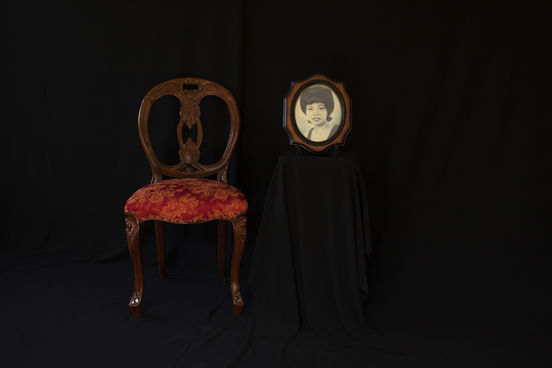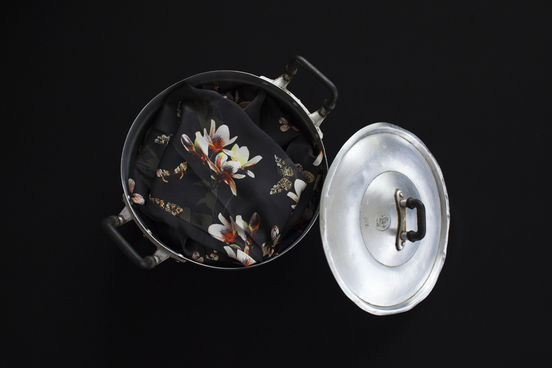-
Author
Zoe Black -
Date
2 Jun 2019
Essay
Alive: Kim Hak interview
During the period of the Khmer Rouge regime in Cambodia more than two million citizens of Phnom Penh were forced out of the city as part of a programme of agricultural reform. They were able to take very few possessions. Families gathered up what was most precious or most practical - only some risked taking photographs or family heirlooms, many were forced to leave all ties to the past behind.
During the regime, precious objects were closely guarded out of fear. Some were wrapped in plastic and buried underground, others were carefully hidden within household utility objects like pots or kettles, in the hope that they would not be found until reaching safety.
Alive is an ongoing project by Cambodian artist Kim Hak that brings these objects into close view, exploring the stories of conflict and personal tragedy they carry with them. For the project Hak, who is based in Phnom Penh, met 12 families who came to New Zealand as refugees in the 1970s and 1980s. He documented the objects that travelled with them as they moved through border camps, refugee centres and ultimately as they settled to start new lives in Auckland. In this exhibition, the photographs appear alongside some of the actual objects. Alive demonstrates the power and importance objects can play in our lives, as vessels for memory and markers of change. The exhibition serves to celebrate Cambodian communities living in Aotearoa, creating a moment for greater understanding of their experience of extraordinary conflict and sacrifice.
This exhibition is the third iteration of Alive with previous chapters shown in Cambodia and Australia. Alive will tour to the Bophana Audiovisual Resource Center in Phnom Penh in August 2019. Kim Hak’s visit to New Zealand and the Alive exhibition are supported by Rei Foundation.
—
Zoe Black: The starting point for the Alive body of work was unearthing relics that belonged to members of your family – photographs and small treasures in particular. What motivated you to create the first series of images, which focused purely on the objects and didn’t include their owners?
Kim Hak: The Alive project did begin with my family’s objects and I wanted to stage them in a poetic way, only giving clues about the stories behind these everyday things, rather than creating an image with the whole story laid bare. I wanted the objects to be shown without their owners because the more families I talked to, the more I realised that there were similar experiences between individuals and the objects they were able to hold onto. Not including people in the photographs meant the images and the stories were relatable to so many others. Their shared experiences could be symbolised by my photograph of a cooking pot, for example, and seeing the images started the families talking more to one another about what they remember. As the project progressed and I started to include other families, they began to ask to be photographed with their objects, so I decided to include one person to represent each chapter.
ZB: How did you come about selecting the objects that have been photographed? Did the selection come after conversations with the families or did the families select the objects as a starting point?
KH: It was a slow process. With the families I was working with in Cambodia, it always began with casual conversations. They would talk, show their items, talk more … I liked to record the conversations so I could play them back and learn more for the next visit. I also liked to sketch the family and their objects as we talked. Once the story became clear, we would discuss how they felt having their object photographed and then, with their permission, we would compose the images. We always shot at the family’s home to make sure they were comfortable.
ZB: Some of the narratives that accompany the images include very harrowing details of the individual’s history. Was there any hesitation from families to speak about their past or were they open to sharing their stories?
KH: Everyone has had to hide these stories inside for many years; they have been too shy or scared to share them with anyone – sometimes even their own families. Now that it has been 40 years, that shame is still there but they aren’t as shy. There is still so much emotion though, I have shed a lot of tears myself learning what these people have been through. This is another reason why I have created this work. Many young Cambodians aren’t aware of the past and what experiences their grandparents and parents have had – especially the ones who have lived overseas and are now coming back to Cambodia. These photographs and the stories are a way of helping them understand.
ZB: All of the photographs produced for Alive are very evocative and staged like memories coming into focus. The objects read like they are beacons in the darkness. Is this the feeling you were trying to convey?
KH: Our history is dark. The black background represents this darkness. I wanted the photographs to show the darkness but also that there is hope. The war made us cautious and relunctant to share our stories. I want this work to help people to stand up and speak again, and the objects are a way to start these conversations.
ZB: Is this why you also wanted to include the objects in the exhibition, alongside the photographs?
KH: The photographs are printed to the same scale as the objects so you can get a sense of what they are like, but it was important to have the objects in the exhibition as much as I could because each has its own feeling – it is a spiritual thing. The objects themselves have their own stories to tell, and having them physically in the exhibition gives the audience the opportunity to see and learn more from the objects.
ZB: You have created three distinct chapters in this body of work. The first was based in Cambodia, the second in Australia and now the third in New Zealand. What was the catalyst for extending out from Cambodia and into these other places?
KH: When I was in the middle of working on Chapter I, two people who were involved in the project passed away. This made me realise that there were so many stories that were not being heard, as the survivors were getting old and it had been many years since the Khmer Rouge. I started researching where the people who escaped had gone and found they had relocated to many different places after being at the border camps – the United States, Japan, France … I was able to connect with families in Australia first and this then led to my coming to New Zealand. There are many more stories to tell of the survivors who have settled in other countries, so my hope is that I can continue adding chapters to the project. It is slow, but I am determined to collect as much as I can, before it is too late.
ZB: You were able to spend quite a bit of time with the families who are in the exhibition when you visited New Zealand in 2018, just as you worked closely with the Australian families to create Chapter II in 2015. Did you notice any differences between the Australian families’ and New Zealand families’ experiences?
KH: Before coming to New Zealand, I didn’t know much about the landscape or the environment. It was the same before I visited Australia. The stories I heard from Australian families were very similar to those told in New Zealand. Many of the stories were very hard to hear – like the people who had to live underground in border camps because they were there illegally and didn’t have authorisation to be at the camp. Some had to live underground for years before they escaped to New Zealand and Australia. This was very surprising to me – I had no idea they went through these awful things.
ZB: Was there anything else you found out that was surprising?
KH: Through their stories I was able to learn so much more about the border camps in Malayasia where many of these families lived for a number of years. I learnt more about what it was like to cross the border and enter these camps – it was such a long process for them and filled with much heartache. The most surprising thing was that many had to convert to Islam while in the camps. I didn’t know this had happened and it was quite shocking for me to find out.
ZB: One of the most haunting works is of Bun Rith Kuy’s watch and a basil plant. It is almost as if you’ve used the plant as a stand-in for his wrist, as if he were made from the basil. Can you tell us more about his story?
KH: There are two photographs of watches in the exhibition. Initially, I didn’t think I wanted to have two photographs of the same kind of item, but the stories of how their owners came to have these watches are so different, and each physically symbolises a different time period – before the Khmer Rouge and after. The first watch belongs to Man Hau and was given to him as a gift by his father before the war. He was able to hold onto it for many years and now it represents a memory of the Cambodia of the past. The second watch is Bun Rith Kuy’s. He bought this watch in a camp just before he left for New Zealand. He had started a business in the camp, growing and selling basil. When he found out he was coming to New Zealand, he decided to use the money he had saved from his sales to buy himself a present – it was this watch. When I was setting up the photograph in his home in Auckland, we picked basil from his garden to include in the image. He is still growing this basil now, in his New Zealand home.
ZB: An equally intriguing composition comes from the contrast between a bird wing and a spiral of barbwire, alongside a book on the history of Cambodia. Are you able to talk about how this composition came together?
KH: I was introduced to this book by Chakara and spent many days thinking about how I could photograph it. I wasn’t sure how to go about it, but knew the book was an important object to include in this project. I was walking around Wellington and this bird’s wing was just sitting on the pavement – just the wing, nothing else. I picked it up and decided to create the image using it and the barbwire. All three things together create a kind of geography – the wing is Cambodia, the barbwire is Thailand and its border camps, and the book is placed further down to represent New Zealand. It is a map of Chakara’s journey to this place, but it can also represent the journey of many refugees.
ZB: Although there is much sadness in the images, the stories show how resilient and determined this community are and how they have overcome the worst circumstances to flourish in a new home.
KH: This project is about the people and their words, their stories. That is the most vital thing – to honour their memories. In photographing the objects in this way I have tried to show that they do not need to hide away their past, but should bring these things into the light. They have overcome so much; it is important we remember, understand their stories and continue to have hope in the future.
— Zoe Black is the Maukuuku Community Development coordinator at Objectspace. She is a curator and writer with recent projects including 'Areez Katki: Bildungsroman' and 'Garden of Memories.'

Alive, Kim Hak, 2019, Refugee box in the survivor’s hands

Kim Hak, watch, and a portrait of Man Hau Liev’s father

Kim Hak, Alive, A portrait from the '70s and a red chair

Kim Hak, Alive, 2019, Soup Pot and Shirt